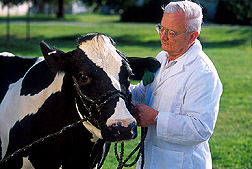Promising New Mastitis Vaccine
|
||
|
Al Guidry is looking for a herd of willing heifers.
He could use about 1,000 of these adolescent cows to test a new vaccine against the toughest form of mastitis—the kind caused byStaphylococcus aureus. Current commercial vaccines immunize against two staph strains that cause only about 40 percent of staph-induced mastitis cases in the United States, slightly more in Europe. And antibiotics are ineffective against staph because the bacteria have become resistant, or they have holed up in regions of the gland where the drugs can't reach. So Guidry, a dairy scientist at the Beltsville (Maryland) Agricultural Research Center, went looking for the missing links. He screened 44 percent of the U.S. dairy herd to find the serotypes responsible for the other 60 percent of staph-related mastitis cases. Collaborator Ali I. Fattom, with the biotechnology company Nabi in Rockville, Maryland, had what Guidry was looking for: a single serotype ofS. aureus—called 336. Fattom, who is involved in developing a human vaccine against staph, knew that 336 accounts for only about 10 to 12 percent of human staph infections. In U.S. cows, however, it's responsible for 50 to 60 percent. The result of this collaboration is a trivalent vaccine containing 336 together with the other two staph strains known to cause mastitis. Whether or not the new vaccine will prevent mastitis still needs to be proved. But it can cure it—even a good percentage of the most recalcitrant cases—when combined with antibiotics. That's according to tests being led by another of Guidry's longtime colleagues, Michigan State University veterinary scientist Phil M. Sears. Sears had been looking for a way to boost the bovine immune system, hoping that a more vigorous immune response combined with antibiotics would control chronic mastitis. And he had good results. When he isolated the causativeS. aureus strain from a dairy herd, killed it, then injected it back into the infected cows a few weeks before administering antibiotics, he cured more than half. But isolating the causative agent from each herd is too cumbersome for commercial use. The trivalent vaccine appears to solve this problem. "It applies to all herds, and it's a purer, cleaner preparation," says Guidry. When Sears tested it in commercial dairy cows, it proved to be as effective as his herd-specific vaccine, curing 55 to 60 percent of infected cows. Because of these promising results, Sears is confident the vaccine will protect heifers from infection. "I don't have any doubt," he says, noting that the vaccine cleared staph infections in about 10 percent of infected cows—even before he administered antibiotics. And it cleared 7 of the 9 cases in the Beltsville herd with the administration of antibiotics, Guidry adds. Nabi and ARS are jointly applying for a patent covering the new vaccine. The company will look for a partner with channels in the agricultural arena to fund further studies and market it. Before the vaccine can go to market, its ability to prevent infection needs additional validation, says Guidry. He figures that will require several years and a whole lot of heifers.—By Judy McBride, Agricultural Research Service Information Staff. This research is part of Animal Health, an ARS National Program (#103) described on the World Wide Web at http://www.nps.ars.usda.gov. Albert J. Guidry is with the USDA-ARS Immunology and Disease Resistance Laboratory, 10300 Baltimore Ave., Bldg. 173, Room 105, Beltsville, MD 20705-2350; phone (301) 504-8285, fax (301) 504-9498. |
|
|
"Promising New Mastitis Vaccine" was published in the November 2000 issue of Agricultural Research magazine. |
||







